Have you ever experienced an achy/sore neck or back while working on a mobile device like a smart phone or tablet? How about a laptop or desktop? If so, you are part of an epidemic. With the explosion of all forms of computers comes an “Electronic Epidemic of pain”. It has been called “Tech Neck” by some authors and health care professionals. I like that term because it applies to the use of any electronic or technical device leading to neck pain.
The pain usually builds up gradually and may go away within a few days or weeks, or it may go and come back in episodes over many years. The neck soreness and stiffness may extend down into the shoulder blades and mid back and may even spread into the arms. It can be a dull ache or sharp at times with movement and may cause headaches. It may be there when using an electronic device or it may bother the person later on at night. The pain will eventually distract the person and negatively impact their activities of daily life.
We know that virtually everyone will experience some form of neck or back pain in their lifetime. And at least 70 percent of neck or back pain begins with normal daily repeated activities like time on an electronic device. Most neck and back injuries are not from falling down or lifting too much. They are from a buildup of repetitive strain and overuse.
What causes Tech Neck?
The cause of Tech Neck is: poor posture and repetitive strain, both occurring over shorter or longer time frames.The following pictures and discussion will illustrate what leads to “Tech Neck”.
Poor posture:
The human spine (neck, mid-back, and low-back) has three natural curves to it when viewed from the side (see diagram). There is a small curve (lordosis) in the neck towards the throat, a curve backwards in the mid-back, and a curve forwards towards the abdomen (lordosis in the low-back). If your neck and back is not positioned properly in these natural curves, pain will develop sooner or later.
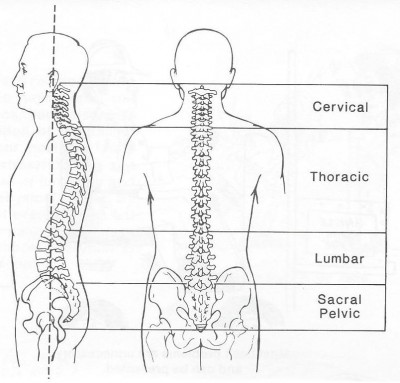
In order to understand pain that arises in your neck from poor posture, try the following experiments:
Experiment 1. Hold a bowling ball or a 15 lb weight in front of you with outstretched arms for 30 seconds. Now hold it close, next to your body. Which position is easier? Guess what, that bowling ball is like a human head, hopefully in terms of its weight only. And if the bowling ball (head) is out front of the shoulders in a head forward posture, the neck muscles have to work very hard to hold it there. If the head (ball) is balanced on top of the shoulders properly, the neck muscles hardly have to work at all. If the head is moved far enough forward it could be putting as much as 27 kg. (60 pounds) of weight on the neck. Normal force on the neck is about 7 kg (15 lb).
Experiment 2. Bend your finger backwards until you feel a stretch. There is no pain now, but hold it there for a minute or two, and pain or discomfort will occur. Pain is a warning signal by your body, and if you allow it to continue, damage will occur. Pain often develops as a result of repetitive strain and stretch on muscles and ligaments over time.
Repetitive strain applies to the above experiments. Repetitive strain is defined as small, subtle amounts of strain, force and overuse, whether its movement or stationary over extended periods of time.
If seated in a poor, slouched posture, then the low-back has lost its natural curve or lordosis, the neck has an increased curve forwards, and the mid-back has an increased curve backwards (picture 1 below). A slouched posture puts the muscles, ligaments, and discs of the spine on an abnormal stretch, just as you tried in the experiment above. Pain can develop in a short time (minutes), or it can take months. The pain can also spread to the head in the form of headaches or into the arms or legs. Often the pain is relieved when changing position, but as time goes on, if nothing is corrected, then the pain will persist in any position. If the posture is not corrected, (in sitting or standing) eventually the muscles and ligaments will shorten and become tighter, and you lose flexibility in the neck and back. A loss of flexibility is also a cause of back and neck problems.
Let’s now look at some pictures showing poor posture and positioning at electronic devices leading to Tech Neck:
Picture 1 Poor posture at a Desktop Computer
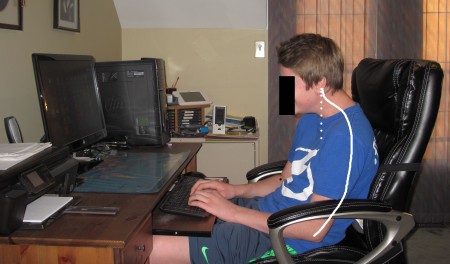
Picture 1 above shows poor positioning and posture at a desk top computer (very common in the teenage years!). Notice the abnormal curves of the spine. The low back and midback are in a ” C” curve position and very slouched. There is no low back lordosis. The mid back curve backwards is larger and the head and chin is poking forward with an excessive lordosis. The white dotted lines show the line of gravity force that is pulling down on the head. Imagine the weight of that bowling ball (head) in experiment 1 being pulled down and forward for hours at a time. The muscle work and strain on the neck and upper back muscles is excessive.
Picture 2 Good posture at a desk top computer
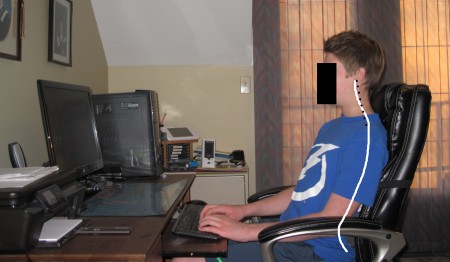
The picture above shows good posture and body positioning at a desk top computer. Notice the white line showing normal spinal curves with the head balanced on top of the shoulders. When the head is balanced on top of the shoulders very little muscle work is required. The black dotted line shows the proper alignment of the ear and the tip of the shoulder. In this neutral position the head is balancing on top of the shoulders and the curves of the spine are in a natural balanced position. The curves of the spine are not exaggerated. Also the head and face are looking straight ahead with no down angle and the elbows are at the sides of the trunk.
Picture 3 Poor smartphone posture

In the picture above using a smartphone, notice:
– The low position of the device, and the elbows positioned away from the sides.
– The down angle of the head indicated with the white arrow. Remember from the bowling ball experiment, that if the head is tilted far enough forward it could be putting as much as 27 kg. (60 pounds) of weight on the neck. Normal force on the neck is about 7 kg (15 lb).
– The slouched posture and abnormal spinal curves as compared to picture 2 above. The chin is poked forward of the shoulders, the midback is slumped, and the low back is in a “C” curve, bowed into the chair.
– The abnormal loading and force acting upon the neck and back above is guaranteed to cause pain and Tech Neck at some point.
Picture 4 Good smartphone posture
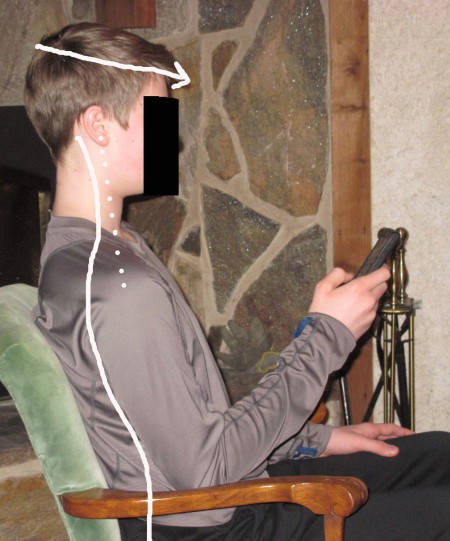
What can be done to reduce Tech Neck?
– It is recommended to hold the smartphone higher with the elbows closer to the side of the body. This reduces the down angle of the head as shown by the white arrow.
– Use an “Active Sitting” approach which brings the person into an upright posture and into a natural position for the back and neck. “Active sitting” is a term used to describe a person using the muscles of their back, trunk and core to sit up against gravity and with proper posture. Notice the natural spinal curves and the head directly on top of the shoulders.
– A good chair with a shaped back piece will make the “Active sitting” easier
– Try standing, which promotes a more natural positioning of the back and neck.
Picture 5 Poor posture using a tablet
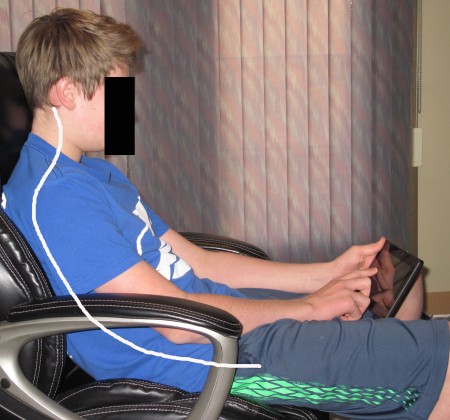
In the picture above, again notice the abnormal excessive curves of the spine and head positioning similar to picture 3. Note also, that even in a good office chair it is easy to slouch. Even the best chairs require some “Active Sitting” and positioning.
Picture 6 Poor positioning using a tablet

The picture above is self explanatory showing poor spinal alignment and is typical in the teenage years! Of note is that postural habits form in the younger years and get harder to break as adults. In our practice we are seeing an increasing number of children and teens with Tech Neck.
Picture 7 Using a tablet properly
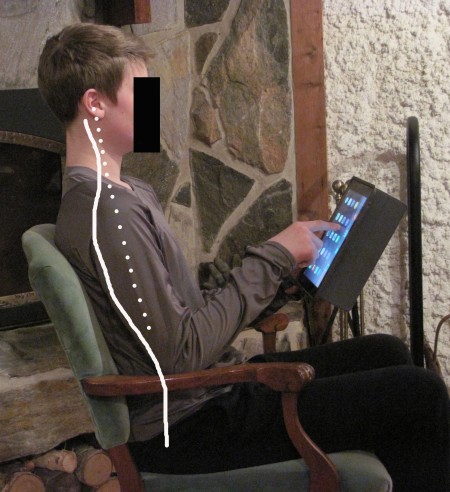
What can be done to reduce Tech Neck with a tablet?
– It is recommended to hold the tablet higher with the elbows close to the side of the body. This reduces the down angle of the head.
– Rest the tablet on a lap pad, which are available commercially in various forms. This raises the viewing angle and allows for an arm rest platform resulting in the neck and arm muscles working less.
– Use an Active sitting approach which brings the person into an upright posture and into a natural position for the back and neck.
– Try standing, which promotes a more natural positioning of the back and neck.
A proper chair with a firm back is helpful but not necessary. A person can sit properly upright on a stool or chair with no backrest, but “Active Sitting” is required. Using the muscles of the back and core to sit up straighter is the key for healthy posture on a backless chair or stool.
Picture 8 Poor posture at a laptop
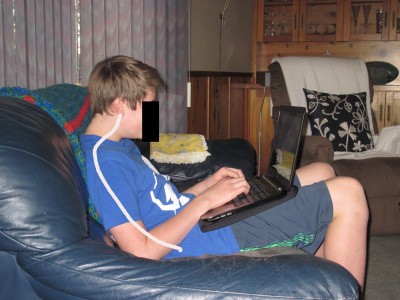
The above picture once again shows a poor slumped posture using a laptop. Although a couch may seem comfortable at first, many couches do not provide proper firm support for sitting in a normal position. Certainly it is not ideal for using a mobile device.
Picture 9 Good posture at a laptop

What can be done for Tech Neck using a laptop?
– Perform the same tips as with the smartphone and tablet.
– A firm upright chair is preferred, making it easier to balance the head on top of the shoulders and aligning the spinal curves in their natural positions. Notice the white dots showing the line of gravity from the ear to the tip of the shoulder which is ideal.
– The screen should be angled upwards for proper viewing angles.
– Using an external mouse or keyboard when a laptop is on a desk, helps promote better posture.
Picture 10 : Good posture using a touch screen laptop
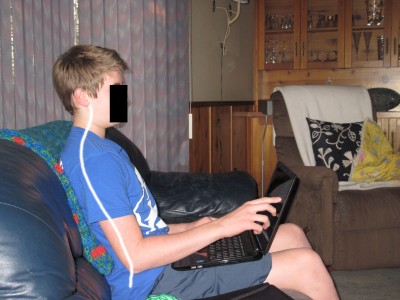
What can be done?
– Perform all the tips above applying to a laptop above.
– Also, the laptop is brought in closer to the abdomen causing the arms to rest at the side of the body not out front.
– Use a lap rest to raise the computer and reduce the reach.
– Using a touch screen is not recommended ( see discussion under picture 12)
-With some effort it is possible to sit up straight on the couch!
Picture 11 : Using a Touchscreen Desk top

When the touchscreen feature arrived for desk tops and laptops I cringed. I cannot see how anyone who uses a computer regularly with this feature could have a painfree neck and shoulder. It is a perfect recipe for repetitive strain and Tech Neck. It is challenging to sit erect usinga touchsscreen because of the counteracting extreme forward position of the hand, arm and shoulder. Notice the white “X” in the picture above. That is the centre of the shoulder sitting forward of its natural position resulting in gravity drawing it down and forward. It also pulls the head forward with it, causing the neck and shoulder muscles to work excessively. Refer to the bowling ball experiment above. I strongly recommend not using the touchscreen feature for these reasons.
What else can you do to treat Tech Neck?
Consider a variable height workstation allowing sit or stand postures. One example is the Varidesk® below.
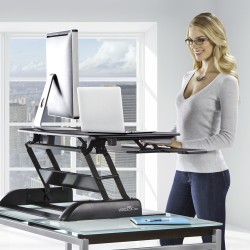
Try the neck retraction exercise intermittently throughout the day. Perform it 5 times every 2 hours. This is an excellent exercise to stretch and elongate the neck removing strain and tightness. It also helps promote a better posture.
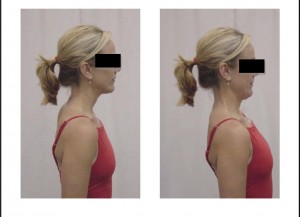
We can help you!
If someone is having trouble getting rid of Tech Neck then consider physiotherapy treatment. Treatment must focus on the root of the problem. If the mechanical cause of the pain is removed (poor posture, poor body mechanics and tight muscles) then the Tech Neck improves. Successful treatment comes with teaching a person about their neck and how to lessen strain and stress on it. Treatment should also focus on special exercises to reduce strain, stretch tight muscles, strengthen and create faster healing.
To also help ease the pain, hands on treatments are used to help the neck or back move and stretch easier. We may use our hands to apply gentle pressures to the spine to help pain, movement and healing. We may also use many proven treatments like ultrasound, heat, acupuncture, and gentle electrical therapy.
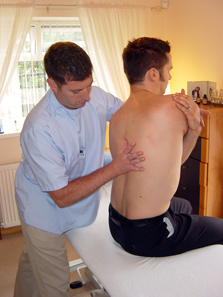
Patients at Corydon Physiotherapy are taught ways of easing the pain at home or at work. Teaching self-treatment and promoting independence is a very important part of our physiotherapy treatment. Patients learn there are no mysteries with neck pain and the more they understand about Tech Neck the faster they reduce the pain.
As a person improves, special exercises are used to strengthen muscles and stretch tight muscles and joints. Our physiotherapists are experts in choosing the right exercises and technique for each person.
Tech Neck can be very painful and prevent work and recreational activity. Addressing it as soon as possible will heal it faster, cut down on medication use, and help a person get back to their passions in life.




